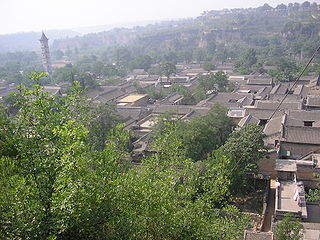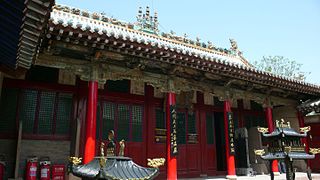
Gaoyao, alternately romanized as Koyiu, is an urban district of Zhaoqing in western Guangdong, China. Population: 706,000.

Sihui, formerly romanized as Szewui, is a county-level city in the west of the Pearl River Delta region in Guangdong province, China. It is administered as part of the prefecture-level city of Zhaoqing. Sihui's population is 542,873 in 2010.

Duke Wen of Jin, born Chong'er, was a scion of the royal house of Jin during the Spring and Autumn Period of Chinese history. He famously endured a long period of exile from his realm before finally being restored to power and rapidly leading Jin to hegemony over the other Chinese states of his time. He is a figure in numerous Chinese legends, including those about his loyal courtier Jie Zhitui, whose death is said to have inspired China's Cold Food and Qingming Festivals.

Ankang is a prefecture-level city in the south of Shaanxi Province in the People's Republic of China, bordering Hubei province to the east, Chongqing municipality to the south, and Sichuan province to the southwest.

Tianshui is the second-largest city in Gansu Province, China. The city is located in the southeast of the province, along the upper reaches of the Wei River and at the boundary of the Loess Plateau and the Qinling Mountains. As of the 2020 census, its population was 2,984,659 inhabitants, of which 1,212,791 lived in the built-up area made of the 2 urban districts of Qinzhou and Maiji. The city and its surroundings have played an important role in the early history of China, as still visible in the form of historic sites such as the Maijishan Grottoes.

The Cold Food or Hanshi Festival is a traditional Chinese holiday which developed from the local commemoration of the death of the Jin nobleman Jie Zitui in the 7th century BC under the Zhou dynasty, into an occasion across East Asia for the commemoration and veneration of ancestors by the 7th-century Tang dynasty. Its name derives from the tradition of avoiding the lighting of any kind of fire, even for the preparation of food. This practice originally occurred at midwinter for as long as a month, but the hardship this involved led to repeated attempts to ban its observance out of concern for its practitioners. By the end of the Three Kingdoms Period, it was limited to three days in the spring around the Qingming solar term. Under the Tang, ancestral observance was limited to the single day which is now the Tomb-Sweeping Festival. The Tomb-Sweeping Festival is an official holiday in several countries, and the Cold Food Festival which stretches either side of it continues to see some observance in China, South Korea, and Vietnam.

Hancheng is a city in Shaanxi Province, People's Republic of China, about 125 miles northeast of Xi'an, at the point where the south-flowing Yellow River enters the Guanzhong Plain. It is a renowned historic city, containing numerous historic mansions and streets as well as over 140 protected historical sites that range from the Tang to the Qing dynasties. As of 2005, it has a population of around 385,000 people.

Zhong County or Zhongxian is a county of Chongqing Municipality, China.

Li County or Lixian is an administrative division of the prefecture-level city of Longnan in southeastern Gansu, a northwestern province of China. The 2010 Chinese census found a population of 458,237, a decline of around 25,000 from the year 2000 but still placing it second in size within its prefecture.

Deqing County, formerly romanized as Takhing, is a county in western Guangdong province, China, under the administration of the prefecture-level city of Zhaoqing.
Fengkai County is a county in western Guangdong Province, China, under the administration of the prefecture-level city of Zhaoqing. It was formed in 1961 from the merger of Fengchuan and Kaijian Counties, which were formerly romanized as Fungchuan and Hoikin respectively.

She County, or Shexian, is a county of southwestern Hebei Province, China, located on the lower reaches of the Zhang River and bordering Shanxi to the west and Henan to the south. It is under the administration of the Handan City, with a population of 400,000 residing in an area of 1,509 km2 (583 sq mi).

Loufan County is a county of Shanxi Province, North China, it is under the administration of the prefecture-level city of Taiyuan, the capital of the province. It is the westernmost county-level division of Taiyuan.

Hunyuan County is a county under the administration of Datong City, in the northeast of Shanxi province, China.

Youyu County, also known by its Chinese name Youyuxian, is a county under the administration of the prefecture-level city of Shuozhou, in the northwest of Shanxi Province, China. It borders Inner Mongolia to the north and west.

Pu County, also known by its Chinese name Puxian, is a county in the southwest of Shanxi province, China. It is under the administration of the prefecture-level city of Linfen; bordering county-level divisions are Yaodu District to the southeast, Ji County to the southwest, Daning County to the west, Xi County to the north, Fenxi County to the northeast, and Hongtong County to the east.

Xi County or Xixian is a county in the southwest of Shanxi province, China. It is located in the northwest of the administrative area of the prefecture-level city of Linfen. The county spans an area of 1,413 square kilometres (546 sq mi), and according to the 2010 Chinese census, Xi County had a population of 103,617.

Jie Zhitui, also known as Jie Zitui, was an ancient aristocrat who served the Jin prince Chong'er during the Spring and Autumn Period of Chinese history. Chinese legend holds that when Chong'er finally ascended to power as the duke of Jin, Jie either refused or was passed over for any reward, despite his great loyalty during the prince's times of hardship. Jie then retired to the forests of Jin in what is now central Shanxi with his mother. Supposedly, the duke so desired to repay Jie's years of loyalty that, when Jie declined to present himself at court, he ordered a forest fire to compel the recluse out of hiding. Instead, Jie and his mother were killed by the fire on Mt Mian. By the Han, Jie was being revered in central Shanxi as a Taoist immortal. He was annually commemorated with a ritual avoidance of fire that, despite many official bans, eventually became China's Cold Food and Qingming Festivals.

Mount Mian, also known by its Chinese name Mianshan, is a mountain in the town of Mianshan in Jiexiu, Jinzhong, in central Shanxi Province in North China. Its official scenic area opened in the year 2000 and covers 75 km2 (29 sq mi), with about 400 attractions grouped into 14 tourist areas.

Hu Yan was a Di tribesman who served as a minister and general of Jin during the Spring and Autumn Period of Chinese history. Hu Yan assisted Prince Chong'er during his long exile, his usurpation of his nephew Yu, and his rise to hegemonic status over the other states of the Zhou Kingdom. The Legalist Han Fei considered Hu Yan one of the best advisors of ancient China, and the historian Sima Qian listed him with Sun Tzu as the greatest tacticians of the age.



















